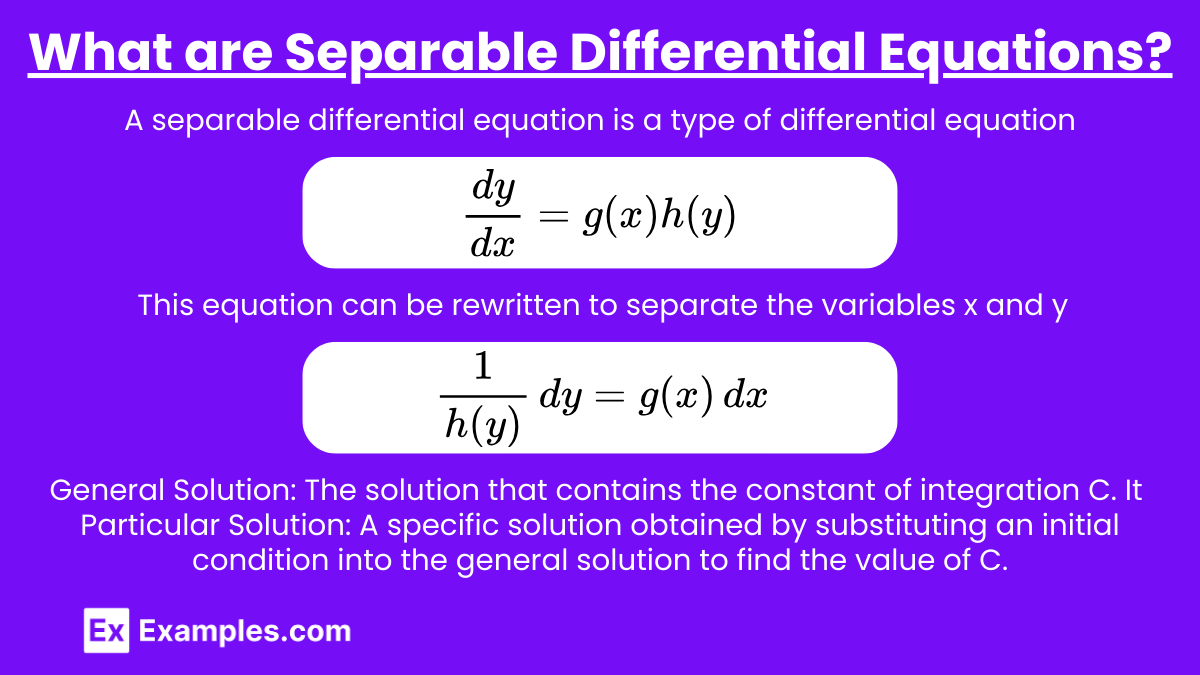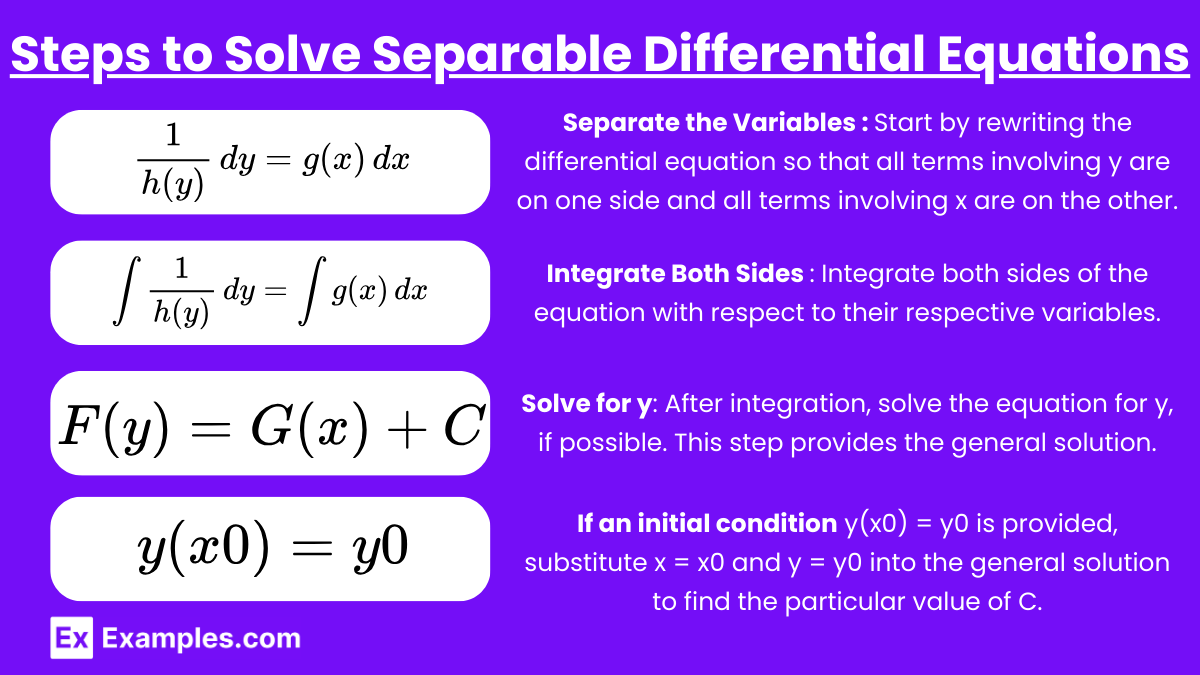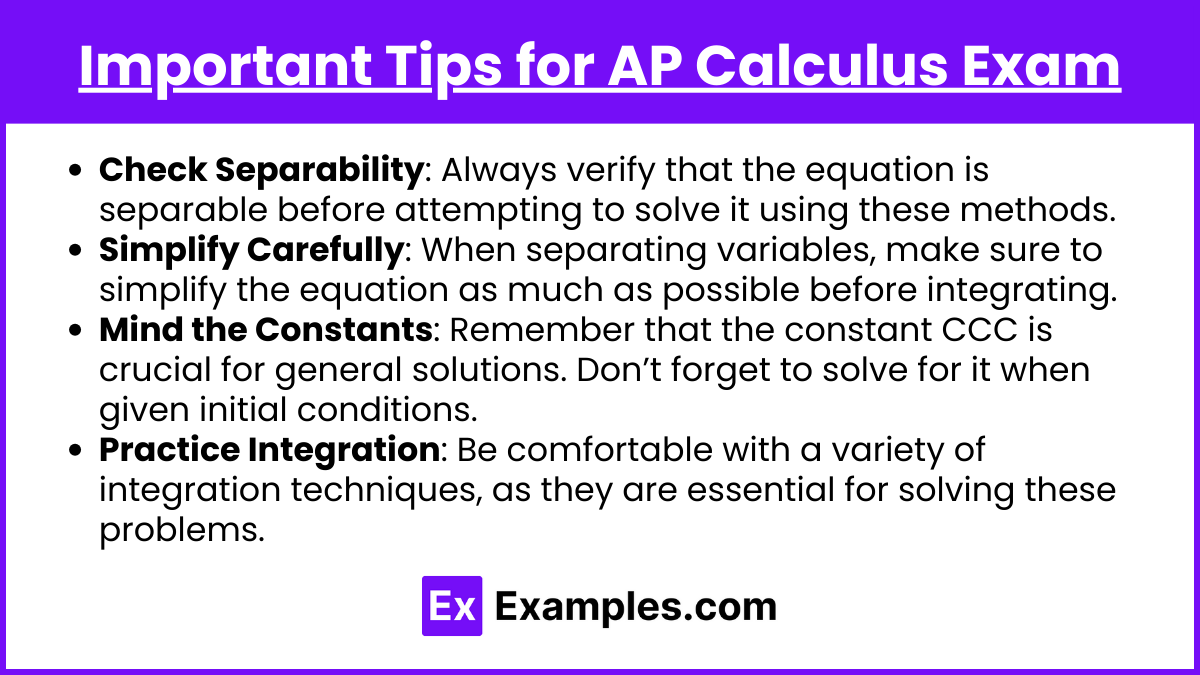In AP Calculus AB and BC, solving separable differential equations is a key technique used to find both general and particular solutions. These equations can be separated into functions of x and y, allowing for straightforward integration. By integrating both sides and applying initial conditions, students can determine a specific solution to the problem. This method is widely applicable in modeling real-world phenomena, such as population growth, cooling processes, and motion under gravity, making it an essential skill for success in the exams.
Learning Objectives
In the topic “Solving Separable Differential Equations to Find General and Particular Solutions” for the AP Calculus AB and BC exams, you should focus on learning how to identify separable differential equations, correctly separate variables, and integrate both sides to find the general solution. Additionally, you should master applying initial conditions to determine particular solutions. Understanding these concepts is crucial for modeling real-world scenarios like population growth, cooling processes, and motion, all of which are frequently tested on the AP Calculus exams.
What are Separable Differential Equations?

A separable differential equation is a type of differential equation. A separable differential equation is one that can be expressed in the form:
This equation can be rewritten to separate the variables x and y:
Key Concepts:
- General Solution: The solution that contains the constant of integration C. It represents a family of solutions.
- Particular Solution: A specific solution obtained by substituting an initial condition into the general solution to find the value of C.
Steps to Solve Separable Differential Equations

1. Separate the Variables
- Start by rewriting the differential equation so that all terms involving y are on one side and all terms involving x are on the other.
.
2. Integrate Both Sides
- Integrate both sides of the equation with respect to their respective variables.
3. Solve for y
- After integration, solve the equation for y, if possible. This step provides the general solution.
- Here, F(y) is the antiderivative of
, and G(x) is the antiderivative of g(x).
4. Apply Initial Conditions (if given)
- If an initial condition y(x0) = y0 is provided, substitute x = x0 and y = y0 into the general solution to find the particular value of C.
- Substitute this value of C back into the general solution to find the particular solution.
Important Tips for AP Calculus Exam

- Check Separability: Always verify that the equation is separable before attempting to solve it using these methods.
- Simplify Carefully: When separating variables, make sure to simplify the equation as much as possible before integrating.
- Mind the Constants: Remember that the constant CCC is crucial for general solutions. Don’t forget to solve for it when given initial conditions.
- Practice Integration: Be comfortable with a variety of integration techniques, as they are essential for solving these problems.
Examples
Example 1: Basic Exponential Growth
Consider the simple differential equation . To solve this, start by separating the variables:
. Integrating both sides, we get
. Exponentiating both sides, the general solution is
, where C is an arbitrary constant. If given an initial condition, such as y(0)=2, the particular solution would be
.
Example 2: Simple Cooling Process
Consider the differential equation , which models a basic cooling process. Separate the variables:
. Integrating both sides, we get
. Exponentiating both sides, the general solution is
. If the initial temperature is
, the particular solution becomes
.
Example 3: Separation of Variables
For the equation ( \frac{dy}{dx} = x \), separate the variables as . Integrate both sides to obtain
, where C is the constant of integration. This is the general solution. If an initial condition such as y(0) = 1 is provided, substituting x = 0 and y = 1 gives C = 1, so the particular solution is
.
Example 4: Population Growth
Consider the differential equation , which models population growth. To solve, separate the variables:
. Integrate both sides to get
. Exponentiating, the general solution is
. If the initial population is P(0) = P0, the particular solution is P=P0e2t.
Example 5: Simplified Motion
Consider the differential equation , which models the velocity of a falling object under gravity. Separate the variables as
. Integrating both sides gives v = −9.8t+C. If the initial velocity v(0)=v0, then the particular solution is v = −9.8t+v0.
Multiple Choice Questions
Question 1
Which of the following is the correct first step to solve the differential equation ?
A. Integrate both sides directly.
B. Separate the variables to get .
C. Substitute y=u⋅v.
D. Differentiate both sides.
Answer: B. Separate the variables to get
Explanation: To solve the differential equation , the correct first step is to separate the variables:
This allows you to integrate both sides to find the general solution.
Answer B is correct because it correctly separates the variables, which is the appropriate method for solving a separable differential equation.
Question 2
After separating the variables in the differential equation , what is the next step?
A. Integrate both sides with respect to x.
B. Integrate both sides with respect to y.
C. Multiply both sides by x.
D. Divide both sides by y.
Answer: A. Integrate both sides with respect to x
Explanation: Once the differential equation is written in a form that separates the variables, the next step is to integrate both sides. For the equation , the variables are already separated, so you integrate both sides with respect to x to find the solution.
This step leads you to the solution .
Answer A is correct because integrating both sides with respect to x is the correct next step.
Question 3
Given the differential equation , what is the general solution?
A. y = C⋅ex
B. y = C⋅ex2
C. y = C⋅ex2/2
D. y = C⋅e2x
Answer: C. y = C⋅ex2/2
Explanation: To solve the differential equation , first separate the variables:
Next, integrate both sides:
This gives:
Exponentiating both sides results in:
Let C′=eC, so the general solution is:
Answer C is correct because it represents the general solution for the given differential equation.


